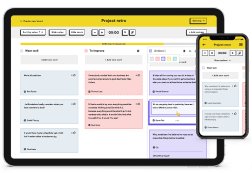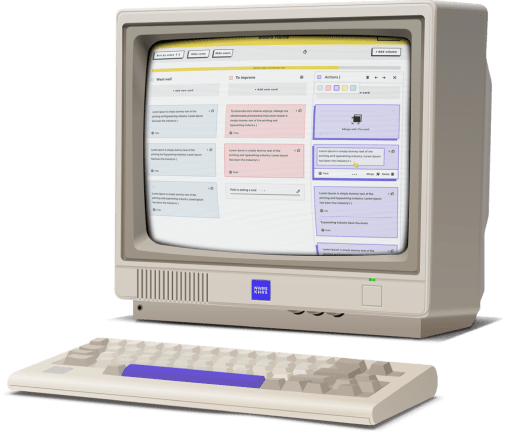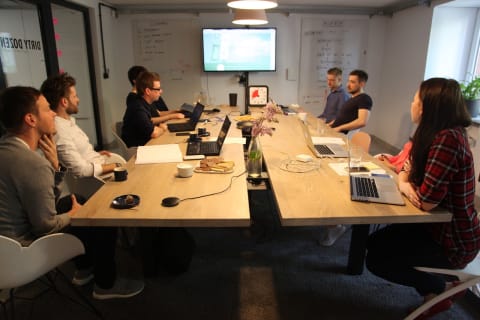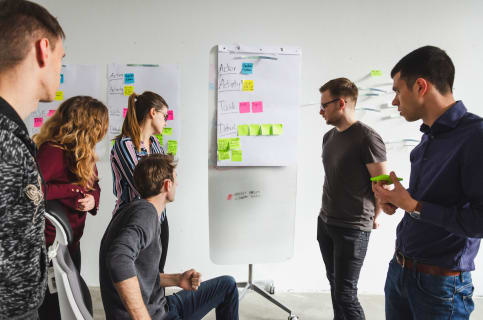Beyond MVP: how we shifted our app towards product-market fit
Back in 2019, we needed a tool that would help us to conduct various meetings online, mainly scrum retrospectives. It was supposed to be lightweight, versatile and easy to use. There are plenty of great applications on the market, but none of them matched our needs perfectly, so we decided to build a tool that would solve our problems. We are a product development and design company, after all!
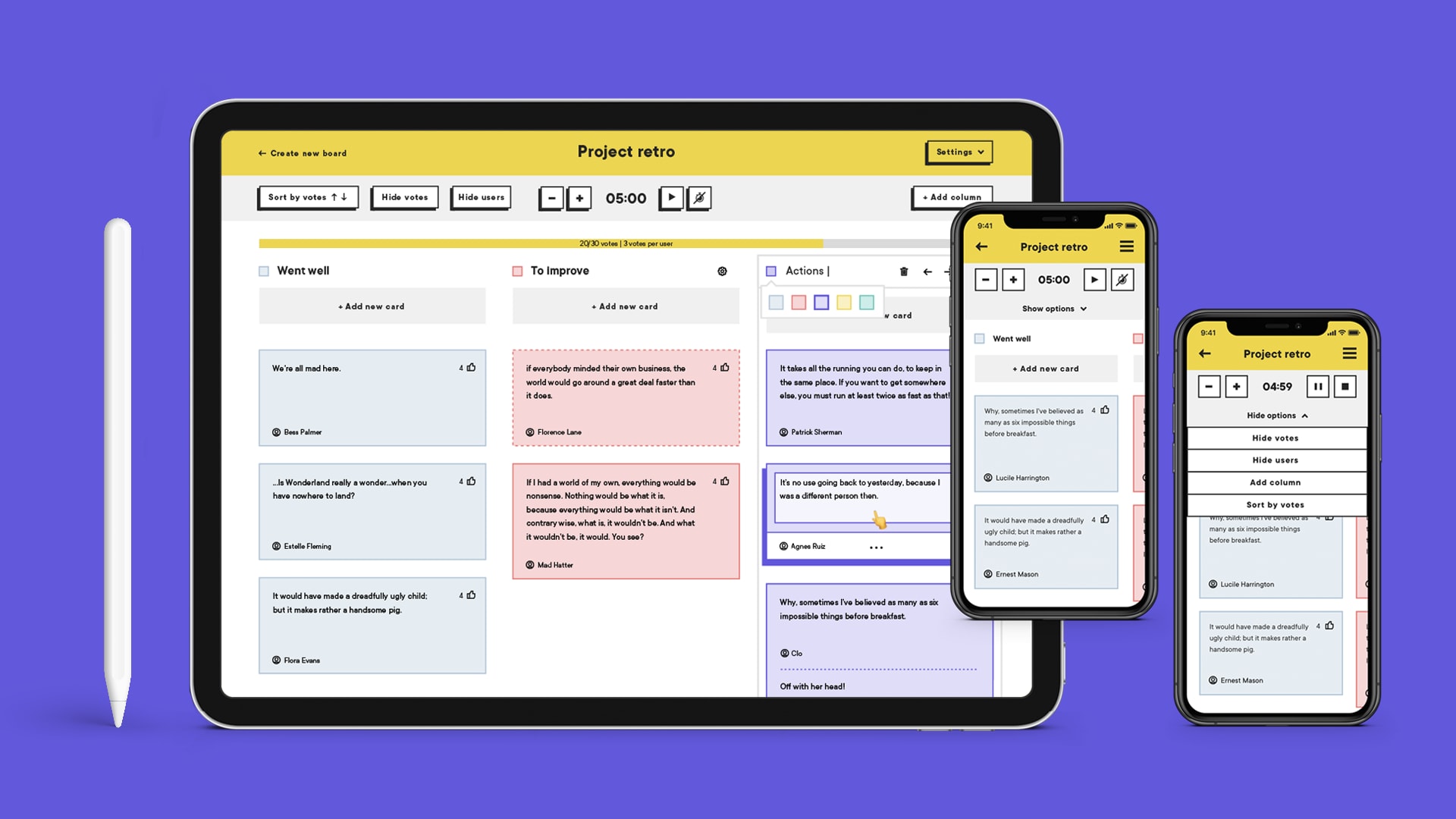
Table of contents
Problem
Why did we decide to invest our development resources into building a brand new product from scratch?
At Boldare, we work using agile methodology. Our development teams are engaged in multiple international projects and collaborate with other remote and distributed teams located around the world. We work in an agile framework called scrum, based on sprints (usually 1 or 2 weeks) and use scrum meetings to organize and prioritize our work. One of these meetings is called a sprint retrospective. It’s used so the team members can summarize the last week or two of their work and discuss recent events - product and team-related.
There are several tools that have been created particularly for this purpose and our teams have used the most popular ones. But various teams using different applications makes it increasingly difficult to store and share information easily and safely. Additionally, our expenditure on application licences was growing each month.
While there’s a great choice of such apps, our needs were quite specific: we needed a tool suitable for conducting sprint retrospective meetings that would be free or inexpensive for our 150 employees, simple to use and, preferably, easily adjustable to our needs.
Solution
After failing to find a suitable solution on the market, we decided to build our own best-fit application. We felt that the odds were in our favor:
- We have, arguably, the best in-house talents for software design and development on our side, so we used them.
- We understood our organizational needs and had a base of highly motivated, potential users to feedback on the product and test it thoroughly.
- We had the determination to create the tool quickly and release it to the organization.
After a brief workshop with stakeholders and product owners, we decided to build an MVP app - a tool suitable for sprint retrospective meetings. Why?
- The minimum viable product model allows us to release apps with basic (but vital) functionality quickly, usually within 4 to 8 weeks, depending on the app’s scope; in this case, it was even less.
- It allows us to validate the business hypotheses with minimum cost, thanks to a shorter time to market.
- It helps us to gather users’ feedback and ideas for future improvements in the product-market fit or scaling phases, so it’s possible to improve the app in the near future.

Our business hypotheses were:
- If we provide our teams with a simple tool, they will use it regularly and we won’t have to rely on external tools.
- We can achieve a positive ROI (short custom development time vs annual fee for an external app).
We kicked-off our process by gathering the needs from across all teams, asking scrum masters and software developers who had worked previously with similar apps to tell us about their ideas for an “ideal” sprint retrospective tool. Then we conducted a product discovery workshop to prioritize goals, define the vision and create the first version of the backlog which helped us to start development quickly.
Our team was composed of a frontend and backend developer, we also used on-demand support from a devops engineer and a product designer. Because we decided to build a minimum viable product, the scope was clear and focused on delivering only crucial features. The main ones to develop were:
- Board creation
- Setting the maximum number of votes
- Ability to vote for cards
- Showing and hiding votes
- Moving cards up and down and across the columns
- Adding and deleting columns
- Changing column names
After the first sprint, the team conducted their first sprint retrospective, using a very early version of the tool. The app had a very basic interface, and functionality - just enough to create a board, cards and set the number of votes per user. It had a very basic UI and practically no product design. The experience of using this first version of the Boldaretro, as we initially named our internal app, was far from satisfactory. However, it was a great first step for the team to gather feedback from the target group of users and implement improvements.

The whole development process took only 15 days (3 one-week sprints), as we focused only on the crucial features for this MVP. After the launch of the app, we started gathering feedback from users. Very soon we were able to validate our initial hypotheses:
- Our teams across the whole organisation started using the tool, providing us with priceless feedback.
- We generated positive ROI, as the total costs related to the tool development were lower than the costs of paying for an enterprise plan for the most popular app, for all our teams.
Boldaretro become the main tool for sprint retrospectives at Boldare
From Boldaretro to the Sprint Retrospective Tool
After the launch of the app and a very warm reception from within the company, we decided to release the tool for free to the open market. Why?
We decided that this could be a great opportunity to strengthen our SEO efforts, by providing traffic and links of high quality to our domain. Besides that, it gave our brand more visibility as a software development-focused company working in agile. We decided to name it the Sprint Retrospective Tool, to highlight its main purpose and make it easy to find using search engines. It took a week-long sprint to prepare, create and launch a new environment for the public version of our own sprint retrospective app.
We decided to keep the internal version of the app as Boldaretro, and released its twin app - Sprint Retrospective Tool to the public in November of 2019.
Making the tool accessible for everyone brought up some security questions. Because we want to keep users’ data secure, we equipped every board with a unique, 32-character identifier created using GUID.It makes it hard to break, even for skilled intruders. Besides that, the tool is built in compliance with GDPR.
To create the Sprint Retrospective Tool and the Boldaretro MVP we used the following technology stack:
Backend:
- ASP.NET Core 2.2
- Kubernetes on AWS
- SignalR
- Websockets / SSE
- VueJS + HackCSS
- LiteDB
- EPPLus - for XLSX creation.
The frontend part was build on:
- React + Context API
- SCSS
- SignalR
What next after the MVP?
In March of 2020, the traffic on the Sprint Retrospective Tool page increased by 400% compared to February. The global outbreak of the COVID-19 pandemic changed the way many companies were working. This situation revealed that many organizations of various sizes and representing different industries were looking for a suitable solution to keep their processes uninterrupted, despite working remotely. We observed recurring users coming from companies like BMW, Shell, the British Home Office and Motorola.
Additionally we received, mostly positive, feedback from the scrum masters and agile coaches community. Positive feedback was not the only good sign coming from the audience: by August 2020, users had created 5,000 boards using the Sprint Retrospective Tool. It had become so popular mainly thanks to word of mouth, as we had invested only 500 euros in promotion.
We believe that the Sprint Retrospective Tool became so popular because:
- It’s free, unlike most similar apps on the market.
- It is intuitive and easy to use.
- It needs no login or account creation to start using it, so it’s perfect for even quick meetings.
- It works on every platform and even with a below-average internet connection.
We were also surprised to learn that more and more people inside Boldare had started using the app as a universal tool to conduct various meetings and not only sprint retrospectives. They were utilizing the tool for:
- remote brainstorms,
- kanban style planning,
- system stories creation,
- team feedback,
- personal notes and self management.
Simultaneously, we were gathering feedback coming from Sprint Retrospective Tool users, and started gathering questions and requests regarding additional features that could be added to both of the apps.
Merging the two separate products
Knowing better what users wanted from the tool, in June of 2020 we decided to improve the existing MVP and merge these two similar but separate tools: the internal Boldaretro and the publicly accessible Sprint Retrospective Tool. We decided to add new features, basing them on the feedback we had collected.
We set three general goals:
- To unify the existing apps and merge them to avoid technical debt and the necessity of supporting two separate versions of the same application.
- To develop new features so the tool could fit the market needs better and make it more useful for different types of meetings.
- To improve the Boldare brand visibility as a software development company that delivers digital products using an agile approach, and increase our lead generation results.
The first step of a new chapter for the Sprint Retrospective Tool and Boldaretro, was the product discovery workshops that we conducted with the stakeholders. The team included a product owner, a frontend developer, backend developer, quality assurance specialist and a product designer. During the workshops we discussed:
- The vision for the product (answering questions like “What is the purpose of the product?”, etc.),
- The target group,
- The business goals (“How is the product going to benefit the company?”).
Knowing the business aims and having a backlog full of great features, we kicked off at the beginning of July. The development process was divided into six sprints, the first lasted for two weeks and the others for one week each. The reason for starting with a two-week sprint is that we decided to run a code audit first, to map all potential issues and consider possible reinforcement of the development team.
Overall, the development took seven weeks and was finished in late August of 2020.
In the new version of the app, our users gained:
- the ability to login using Google Account, and save boards,
- a feature to export data in a form of CSV files,
- a timer to keep meeting agendas on track,
- drag and drop for cards,
- easier merging of cards, including being able to drop one on top of another,
- serial numbers for cards,
- a choice of color for the cards, depending on the column they’re in.
We also changed the name of the tool to Boldare Boards to unify the products and highlight our brand.

To make the marketing impact even bigger, we designed and developed an entirely new landing page of the tool and submitted it to the Awwwards website - one of the most influential and prestigious web design competitions. After the judging process, we won an Honorable Mention and Mobile Excellence award, and received an amazing average score of 8.63 points from the professional designer community and design agencies. Winning this award resulted in increased traffic and better visibility for Boldare, as a design award-winning company.
Boldare Boards technology stack
We used React and Typescript for the frontend and .Net/C# for the backend.
The app is backed on Kubernetes, PostgreSQL, Travis CI, CD Helm with Skaffold and Netlify.
The product-market fit phase of Boldare Boards
The phase of a product’s development that comes after the MVP is called product-market fit. It’s a natural step in an application’s development, before scaling the product and the whole business.
Product-market fit is suitable for products that are already on the market and have a group of active, engaged users. The main goal of the product-market fit phase is to equip the product with features that are desirable in the market. It’s all about adding and verifying new features, balancing user needs and the technical and financial capabilities of the company. The natural result of a mature product-market fit phase is a product that grows organically, because it provides desirable features to the target group.
It’s also an introduction to scaling - once the product has the best possible characteristics, it’s mature enough to be released in new markets or opened up to a new group of users.
Where is Boldare Boards in the product-market fit phase? We are just embarking on the journey, focusing on delivering much-demanded features thanks to user feedback and doing our best to provide an app that offers high quality while remaining free for everyone.

Boldare Boards’ impact on our business
We started Boldare Boards as an internal product that was supposed to answer our needs only. Thanks to the MVP concept, we were able to build and release not one, but two applications within a very short period. Now we are releasing a new, improved and refreshed tool to a vibrant community that has had a real influence on the app.
Moreover, thanks to our products we’ve gained new business opportunities: we are currently working on selling licenses to use Boldare Boards to two middle and large-sized companies from Western Europe. We also receive on average, three sales opportunities monthly thanks to marketing campaigns dedicated to Boldare Boards and the awards we won. Our organic website traffic has grown by 5% to 10% monthly, thanks to the SEO potential of the tool.
But most importantly, we gained a base of really engaged users whose daily work became a little bit easier thanks to Boldare Boards.
Share this article:

